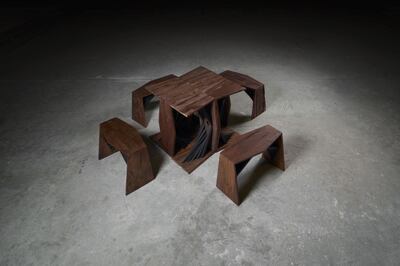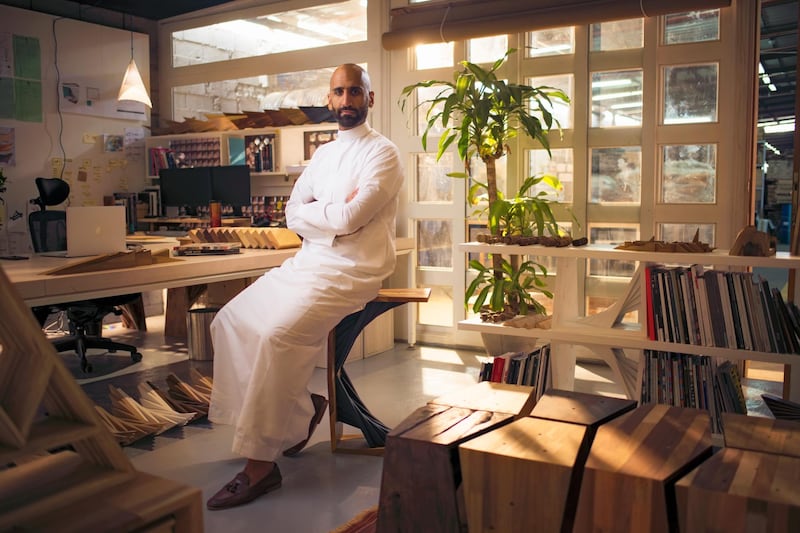With their edgy lines, off-balance proportions and twisted metal features, the designs of Saudi architect Albara Osama Saimaldahar are akin to furniture from a futuristic sci-fi film, except for their use of wood.
Alongside other materials from his country’s natural landscape, Saimaldahar fuses his innovative creations with solid wood from a variety of trees, their diverse tonal aspects harmoniously illuminating each piece.
Such unique works are created inside Dahr Design Studio, which he established in 2016 and is set inside of a 30-year-old furniture factory in Jeddah. The firm strives to make an impact through the creation of objects, buildings, spaces and infrastructure that elevate their users’ way of life. “We are a team of problem-solvers dedicated to looking for the opportunities that might traditionally be overlooked,” he says. “We utilise Saudi’s rich resources, from materials, processes, talent and capabilities.”

The Middle Eastern country has been the subject of much media interest over the past 22 months. Mohammed bin Salman bin Abdulaziz Al Saud, Crown Prince of Saudi Arabia, has pushed through sweeping reforms, making headlines worldwide. Within these changes, perhaps measures of their reach is Saudi Arabia’s visual arts and culture scene, which has quickly been transformed.
Working amid such developments, Saimaldahar hopes not only to develop his country’s design scene, but also to encourage Saudi Arabian youths to engage in arts and culture. Events such as Saudi Design Week in Riyadh, which drew to a close this week, and Tasmeem, a non-profit design and architecture fair staged by the Saudi Art Council for the first time in Jeddah in November, offer people the opportunity to learn more about local talent, both regionally and internationally. “There is demand in Saudi for home-grown designs and products, and that is extremely exciting,” he says.
In September, Saimaldahar was among a group of 12 designers selected from the Gulf region to take part in the International Designers workshop, organised by the British Council and V&A Museum during the London Design Festival and London Design Biennale. The two-week event provided visitors with the opportunity to interact with creative professionals and designers from all over the world, as well as increase the potential for collaboration and commercial partnerships between the United Kingdom and the Gulf in the area of design.
“My vision is to further evolve our rich local identity by impacting people’s lives regionally and internationally,” he says. “I want us to be an example of a Saudi design house or brand that speaks a language comprehended and celebrated across the world.”
Saimaldahar holds a bachelor’s degree in architecture from the University of Manchester in the UK, and started his career as an architect at the London-based firm, Skidmore Owings & Merrill. After two years, he returned to Jeddah and worked on a number of projects. He debuted his brand to coincide with the launch of its first product, Qaws – a multifunctional and interactive piece, it was developed from the idea of a conventional stool in dialogue with a table. From a chair to a high table or a coffee table, the versatility of the piece is endless.
_____________________
Read more:
Elias and Yousef Anastas: the artisans mastering musical chairs
Tips on how to create your own hotel-inspired home
16 simple hacks that will make your lodgings look luxurious
_____________________
“The product form is a puzzle-like module where the more pieces you integrate, the more possibilities it gives you,” he explains. Qaws, which means “arc” in English, refers to its countless uses. “Our fascination with anamorphosis was the way in which we chose to pay tribute to the Islamic geometry and architecture that inspired the design,” he adds.
Ultimately, Saimaldahar aims to utilise the power of craft and architecture to maximise the potential of local design and manufacturing. “We research and develop local craft with a design vernacular to the point where one can create poetry that speaks to the generations of today,” he says.










